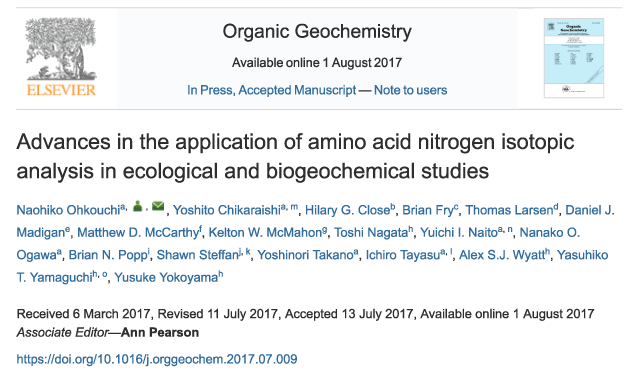Advances in the application of amino acid nitrogen isotopic analysis in ecological and biogeochemical studies
Naohiko Ohkouchi1,*, Yoshito Chikaraishi1,13, Hilary G. Close2, Brian Fry3, Thomas Larsen4, Daniel J. Madigan5, Matthew D. McCarthy6, Kelton W. McMahon7, Toshi Nagata8, Yuichi I. Naito1,14, Nanako O. Ogawa1, Brian N. Popp9, Shawn Steffan10,11, Yoshinori Takano1, Ichiro Tayasu12, Alex S.J. Wyatt8, Yasuhiko T. Yamaguchi8,15, Yusuke Yokoyama8
1 Department of Biogeochemistry, Japan Agency for Marine-Earth Science and Technology, Japan; 2 Rosenstiel School of Marine and Atmospheric Science, University of Miami, USA3 Australian Rivers Institute, Griffith University, Australia; 4 Leibniz-Laboratory, University of Kiel, Germany; 5 Harvard University Center for the Environment, USA; 6 Department of Ocean Sciences, University of California, Santa Cruz, USA; 7 Graduate School of Oceanography, University of Rhode Island, USA; 8 Atmosphere and Ocean Research Institute, The University of Tokyo, Japan; 9 Department of Geology and Geophysics, University of Hawaii, USA; 10 US Department of Agriculture, Agricultural Research Service, USA; 11 Department of Entomology, University of Wisconsin-Madison, USA; 12 Research Institute of Humanity and Nature, Japan; 13 Present address: Institute of Low Temperature Science, Hokkaido University, Japan; 14 Present address: Nagoya University Museum, Japan; 15 Present address: Lake Biwa Environmental Research Institute, Japan
Compound-specific isotopic analysis of amino acids (CSIA-AA) has emerged in the last decade as a powerful approach for tracing the origins and fate of nitrogen in ecological and biogeochemical studies. This approach is based on the empirical observation that source amino acids (AAs) (i.e., phenylalanine), fractionate 15N very little (< 0.5‰) during trophic transfer, whereas trophic AAs (i.e., glutamic acid), are greatly (∼6–8‰) enriched in 15N during each trophic step. The differential fractionation of these two AA groups can provide a valuable estimate of consumer trophic position that is internally indexed to the baseline δ15N value of the integrated food web. In this paper, we critically review the analytical methods for determining the nitrogen isotopic composition of AAs by gas chromatography–isotope-ratio mass spectrometry. We also discuss methodological considerations for accurate trophic position assessment of organisms using CSIA-AA. We then discuss the advantages and challenges of the CSIA-AA approach using published case studies across a range of topics, including trophic position assessment in various ecosystems, reconstruction of ancient human diets, reconstruction of animal migration and environmental variability, and assessment of marine organic matter dynamics with new classification of microbial fractionation patterns. It is clear that the CSIA-AA approach can provide unique insight into the sources, cycling, and trophic modification of organic nitrogen as it flows through systems. However, this approach will be greatly improved through continued exploration into how biochemical, physiological, and ecological mechanisms affect isotopic fractionation of individual AAs. We end this review with a perspective on future work that will promote the evolution of the rapidly growing field of CSIA-AA.

